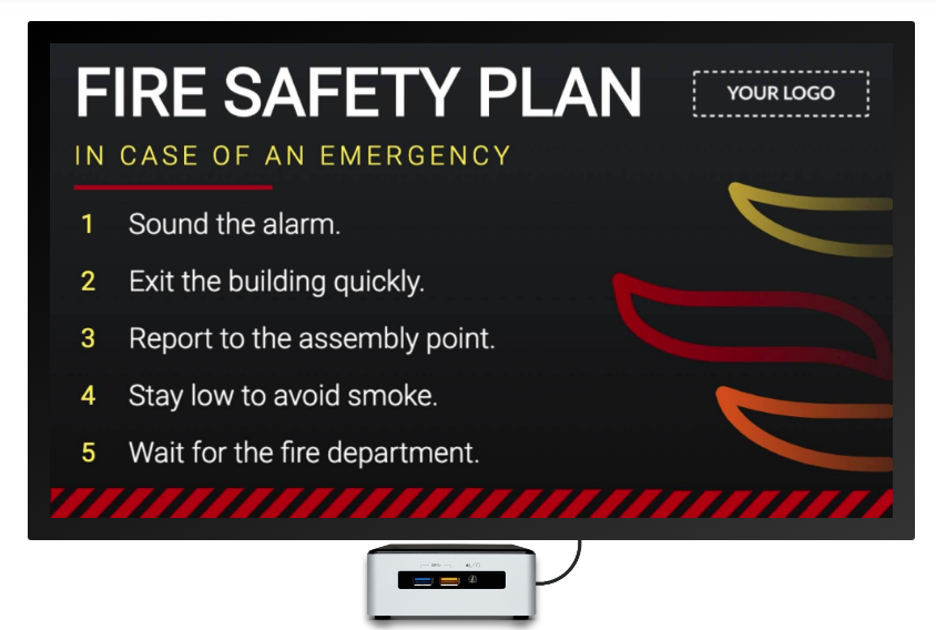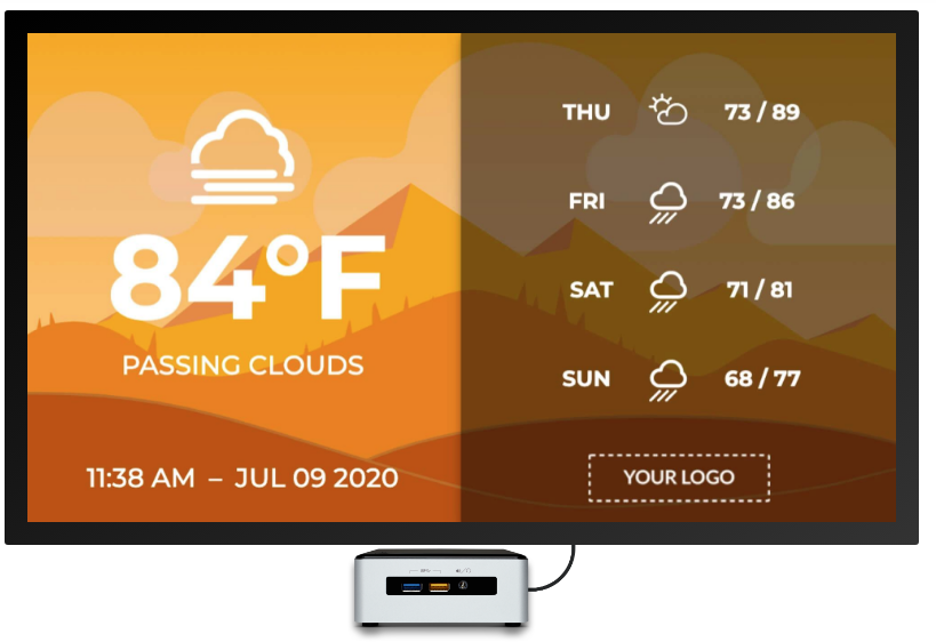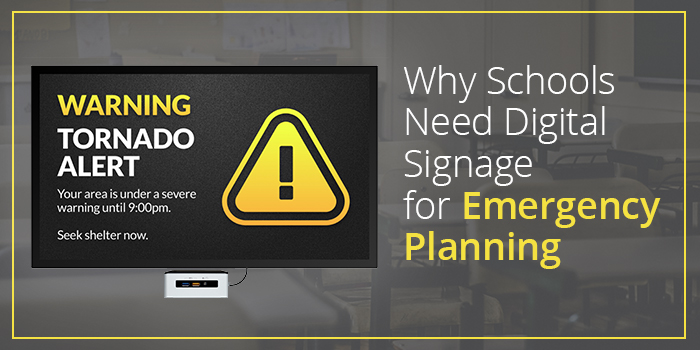This guest blog post was contributed by our digital signage partner, Rise Vision.
Effective Digital Signage
Digital signage is an effective way to communicate with staff, students, and visitors. It can be more effective than static signage in ordinary times, bridging the communication gap and keeping everyone in the know.
But in emergencies its ability to rapidly transmit information in real time to a specific audience and be shown on selected screens means it can help implement your fire drill or disaster plan, improve compliance, and help save lives.
Why Schools Need Emergency Notifications
Schools have a duty of care to their students and a similar duty to their employees. A school might contain a thousand teenagers or 200 elementary schoolers, all with sharply differing needs. A sign that makes instant sense to a seventeen-year-old might not even register to a seven-year-old. And it’s also important to take into account the school’s faculty and non-teaching staff.
Regardless of strong differences in comprehension and attention across the whole school population, though, we can generalize about the types of situations where schools need emergency notifications.
Fires and floods: disaster management
Sometimes, unpredictable or short-notice changes mean everyone in the school needs to know what’s happening, and what to do, immediately. This can happen in the event of a fire or flood; it can be when a storm or hurricane changes course. It doesn’t have to be a scenario where every second counts and only minutes of warning time are available — when parents have to reschedule pick up for their kids and emergency services have to be deployed, a day’s notice doesn’t feel like much.

Intruders
Dangerous intruders rarely enter school grounds and when they do, the issue can often be dealt with behind the scenes, without involving the school body as a whole. But sometimes the whole school needs to get involved in safety drills.
Bad weather: Snow day drills and heatwaves
Canceling school, arranging transportation for everyone who’s already there, and managing students, staff, and visitors amid worsening weather and shortening tempers is an ideal use case for digital signage, with its proven ability to communicate quickly and clearly.

Illness and injury
When key staff aren’t able to perform their roles due to illness, injury, or for some other unforeseen reason, the students they’re supposed to be leading need to know about the change of plan quickly. A specific contingent of the student body needs clear information immediately, and digital signage is ideally placed to provide this targeted communication.
How are emergencies dealt with?
Whatever the nature of the emergency, the range of responses is often similar. It includes:
Evacuation
What is it?
All students and staff move from the school building to a pre-designated safe location until the cause has been dealt with and they can return. This is what schools practice doing during fire drills.
How does digital signage help?
However many times you practice evacuation drills, getting a complex mix of groups like a school population to go where they’re meant to is tough. Under stress, people get lost or panicked; a clear line of escape marked by signed instructions can help, as can reiteration of general evacuation procedures and instructions.
Relocation
What is it?
Evacuate, but don’t then return to the school buildings. Instead, go to another predetermined safe location. This might mean students go home early or to another school-owned site.
How does digital signage help?
Directing students to specific locations once they leave school grounds might be best done while they’re still inside the school. Where it’s not, students’ mobile devices can be used to direct them; ideally, an overarching communications system that both manages digital signs and communicates with mobile devices will be used for this.
Shelter in Place
What is it?
Shelter in place means remain where you are, stay safe, and wait for further instructions. It usually also interrupts schedules that rely on moving from place to place, like students switching classrooms. It’s what we do when the main threat is something like smoke from a nearby fire or certain types of floods or storms. It may also be familiar to some from active shooter drills.
How does digital signage help?
Digital signage lets you quickly communicate with multiple groups of people, including staff and students who need to stay where they are and others who now need to be rerouted or redirected to take account of still-full classrooms or off-limits corridors.
Lockdown/Lockout
What is it?
Lockdown means everyone stays in the room they’re in, doors and windows are closed and locked if possible, and everyone stays away from the doors and windows. It’s used when there are certain types of threats inside the building, usually when law enforcement is on the way. Lockout means access to the building is restricted, though there may be movement inside the building.
How does digital signage help?
Digital signage lets you communicate the status of an evolving situation to locked-down or locked-in students and staff in real-time, offering reassurance, and increasing compliance with simple protocols that help save lives.
Using digital signage for emergency alerts
Digital signage has been proven to be more effective than static signage — the statistics are drawn from business rather than education, but the trend toward increased attention, recall, and behavior change is significant and solid.
For emergencies, a fundamental attribute of digital signage is even more relevant: you can change the information displayed, quickly and from a single dashboard.
CAP alerts
FEMA uses a system called Common Alerting Protocols, or CAP alerts, letting the same emergency broadcast be made to digital signs across multiple affected locations simultaneously, and says there are several benefits to CAP alerts, including:
- Add multimedia such as maps and photographs, or streaming video and audio
- Geographically target emergency alerts to specific, predefined areas
- Serve the needs of people who are hard of hearing, have reduced vision or mobility, or who have different cognitive requirements
- Send alerts in multiple languages, especially useful for schools whose student body is bilingual or contains a high proportion of students for whom English is not their first language.
All these benefits are available through CAP programs, but they’re also available through well-designed digital signage solutions.
The major advantage of a solid digital signage system for emergency alerts is that you can build emergency alerts ahead of time, target them by location around the school building, and then deploy them instantly from the dashboard.
Creating emergency digital signage
Building your own emergency digital signage isn’t that difficult. It’s largely a matter of planning so that your emergency notifications are ready when there’s an emergency. The last thing you want is to be in a position where you’re rushing to create notifications while the clock ticks.
Plan out which types of events are most likely to happen in your area. If you’re in Kansas, you probably want tornado warnings. If you’re in Boston you can probably skip those and concentrate on snow.
Once you’ve identified likely troubles, you now need to figure out who needs to know what. First-graders don’t need to know details of driving conditions, they need to know that there’s going to be a shorter school day or a longer wait at the end of it. Teachers need both. Parents already know the roads are mired in slush, but they need information on what the school is doing so they can plan. Prepare adequate signage for each group, letting them know what they need to know.
At each point, this process is much easier if you’ve chosen a digital signage system that gives you things like templates for events, network management, integration with emergency notification systems, as well as easy setup, media, and display options.
Templates speak for themselves. If you don’t want to add a Graphic Designer to the list of things you need to be an expert in to work in education, you need adaptable, easy-to-use templates that let you get the message out.
Network management means you can run the whole system from one place. If you want to show one set of signs in one part of the building and another in another area, you can manage that straight from your laptop. You don’t want to be walking around the school doing this by hand. Systems that offer this are often hardly more expensive, but it will save you hours of wasted time.
Integration with other alert systems lets you communicate with students and staff by onsite digital signage and with parents offsite by email, weblinks, or SMS, making sure you can get information to everyone who needs to know.
Conclusion
Digital signage answers the need for a versatile, effective way to communicate vital information quickly to specific audiences during an emergency. It can be connected with emergency notification systems so people on and off campus can be alerted simultaneously. And it has the potential to improve compliance with emergency protocols and help keep order, reassure students, staff, parents, and visitors, and help keep everyone safe.
Visit our Technology Integrations page to learn more about our digital signage partners.
